QuestionKaren,
Thanks for being available to answer novice questions about freshwater aquariums. I've reviewed several problems/questions/answers on this site, and you seem to be the most appropriate person to help me resolve my issues. I'll try not to be long-winded, but you did say to be specific and give as much information as possible. So, here goes...
I recently converted my 10-gallon tank from all artificial plants to live plantings on 10/25/06. I performed a complete water change and cleaned the tank and ornaments with a mild vinegar solution. I changed the gravel from a blue-colored gravel (the color kept clouding the tank) to a natural river-rock type of gravel. I planted 6 new types of plants: 1 Umbrella Plant, 1 Tropica Fern, 1 Borneo Sword, 1 Gold Ribbon, 5 Frill Plants, and 2 Cabomba Plants.
I allowed the tank to cycle for 5 days (I know...not long enough), before I allowed my 9 year-old grandson to pressure me into buying a snail and two African Dwarf Frogs to add to the tank. Once we arrived at the pet store, we were advised not to add a snail until the tank had cycled for at least 30 days since there was no algae present in the tank. We were also advised not to add the dwarf frogs until the tank had cycled for at least 8 days.
We did not purchase the snail, but did purchase the two frogs. However, once we got home and I tested the tank before adding the frogs, I did discover that an ammonia problem had occured. I couldn't understand what had caused the ammonia problem since there were no fish in the tank, so I performed a 75% water change on 10/30/06 which immediately corrected the problem. I added the frogs and 1 Ghost Fish (which had been in the tank prior to me adding the live plants) back into the tank.
PLEASE NOTE: I had a SEVERE ammonia problem weeks before and was only able to resolve it by a complete tank cleaning. The Ghost Fish was the only survivor (of an original 12...I overstocked when I first set up the tank) of that disastrous episode. I didn't want to put him back in the tank, but my grandson insisted.
Karen, I know I've made a lot of mistakes, most of which are the result of my own impatience and or from giving in to my grandson's requests. I honestly HAVE done the research and know what, theorectically, I'm supposed to, but have not always followed the rules. If I can be forgiven for my past mistakes (I know there's a Fish-God looking down on me)...please help me, the latest of my problems, get past this current dilema.
Since I planted the live plants and added the frogs and Ghost Fish, I have noticed several potential problems. First of all, the plants seem to "shed" a lot. Debris floats in the water, gets stuck on the filter intaks tube, lays on the bottom of the tank, and adheres to other plants. I'm sure it's the Frill and Cabomba plants that are doing the shedding, but, honestly they are my favorite plants and I don't want to get rid of them. Is there a point at which they "settle down" and stop this process?
Secondly, is there a food that I can feed my fish that doesn't leave so much waste. I am currently alternating between TetraMin Tropical Flakes (Clean Water Formula), TetraMin Tropical Crisps (which advertise up to 35% Less Waste), Aquarium Tropical Floating Pellet Food), and Omega One Freeze-Dried Brine Shrimp Nutri-Treat (which I bought specifically for the frogs.
No matter what, all these foods leave an inordinate amount of waste. What appears to happen, primarily, is that the fish/frogs don't "see" the food when it's added to the water and it floats to the bottom. I was told at the pet store that the frogs were bottom feeders and would eat the residual food. That's just not true. They actually swim to the top of the tank to eat the Brine Shrimp and don't seem to eat the flakes at all. The pellets either stick to the filter intake tube or just turn to mush and float at the top of the water.
I know I've gone on much longer than even I anticipated, but I guess my overall question is...can you recommend a solution to my current problems...plant wastes, a better feeding solution, and a true "bottom-feeder" that can eat the excess food at the bottom of the tank.
Please don't hesitate to ask additional questions if they would be of assistance to you in finding a solution to my problems.
Thank you in advance for your help.
Marilyn
P.S. Recommendations on how to appropriately clean my live plant aquarium would be greatly appreciated.
AnswerDear Marilyn,
Thank you for your thorough and informative letter. I really do appreciate as much info as possible as this helps greatly in solving the problems at hand.
I wonder what could have the caused the severe ammonia problem before. I highly suspect it is due to two things. The aquarium was not cycled properly or not gradually and slowly stocked and possibly the fish were overfed. Especially because of the small water volume, pollution and ammonia problems are even greater. An aquarium takes up to 4-6 weeks to fully cycle or establish special beneficial bacteria whom are so vital to any aquarium to keep ammonia and nitrite levels at zero.
Ideally it's best to stock a newly setup aquarium with only 2-3 small hardy fish for the first few weeks of cycling with daily testing for ammonia or nitrite spikes. Should there be any, an immediate large water change is definitely in order. As your aquarium establishes and ammonia and nitrite levels dropped to zero and nitrate has appeared, which indicates your beneficial bacteria have established you can then add a few more fish..But be sure to test your ammonia the next day to be sure no spikes have occured due to the new bioload addition.
I'm sure you probably already know all this but it is well worth mentioning.
The ammonia problems even without fish only lead to one possible cause-- The plants shedding their leaves. If there is excess decaying plants and lots of leaves floating around like you mentioned I would highly suspect this is the cause of the ammonia problem. Cambomba is bad about shedding it's leaves, sometimes this happens when it is first added to a new aquarium and may slow as it gets established and well-rooted.
The flake foods you have now are of good quality. But you should never allow excess food to sit in your aquarium. Your frogs and fish may do better with frozen food like worms, or brine shrimp instead of freeze dried food that they may find not as good. Make sure to control the portions of food and remove any uneaten food. Dwarf frogs may be best fed with a unused eyedropper with their food squirted gently in front of their nose.
You will have to clean up a lot after your cambomba plants with by siphoning the leave or netting them out as much as you can. It's best to feed your fish and frogs lightly a few times a day. A true bottom feeder would be a Corydoras catfish...These catfish are greatly little scavengers that do best in small groups.
Cleaning a planted aquarium generally is the same as unplanted tank. Use a gravel vacumm and lightly siphon the debri around the plants but be careful not to chop plant roots with the siphon tube. Everywhere else can generally be well-vacummed as long as you aren't too close to your plants. It's very important to make sure all areas of your substrate (gravel) are gently stirred to prevent any debri from accumulating too much. Use your fingers in places where a siphon can reach to gently stir the gravel and aeriate it on occasion.
I really hope this helps and feel free to write if you have anymore concerns!
Best wishes,
Karen~
I would be sure to get your aquarium established and cycled before adding anymore fish for now.

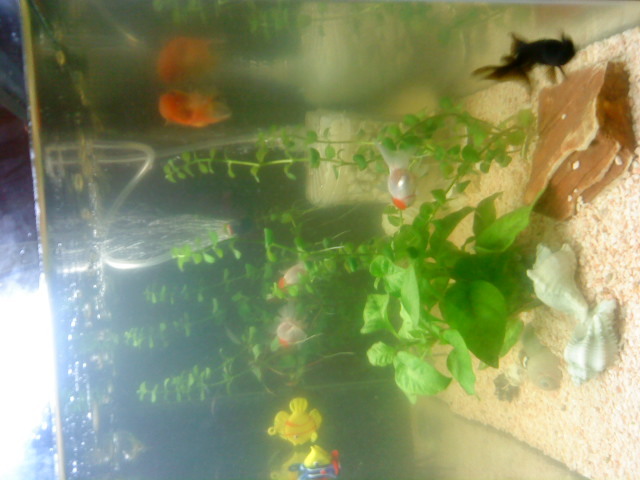 compatibility
Question
fish027
Hi Susan I have a 50litre tank
compatibility
Question
fish027
Hi Susan I have a 50litre tank
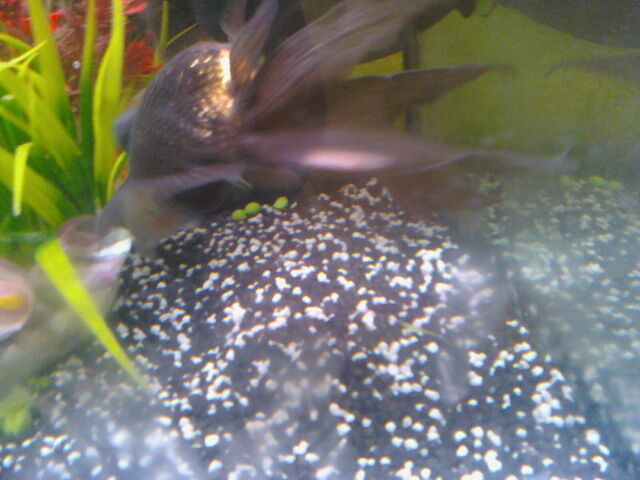 RE: Sick blackmoor
Question
Blackie
Hi,
I just want some advice on a blac
RE: Sick blackmoor
Question
Blackie
Hi,
I just want some advice on a blac
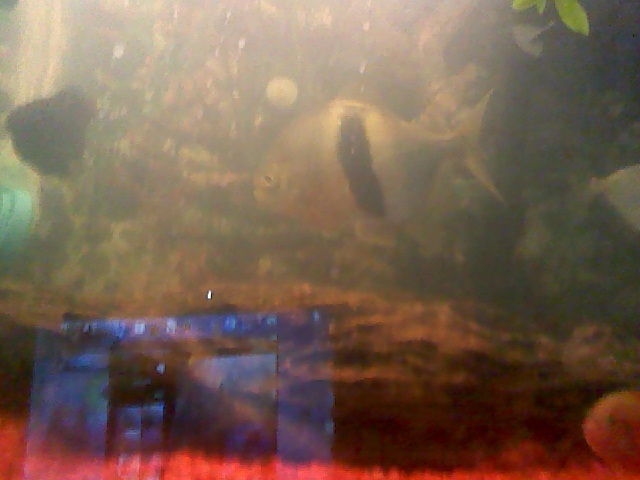 wide bar silver dollar
Questionmy wide bar silver dol
QUESTION: Hello I
wide bar silver dollar
Questionmy wide bar silver dol
QUESTION: Hello I
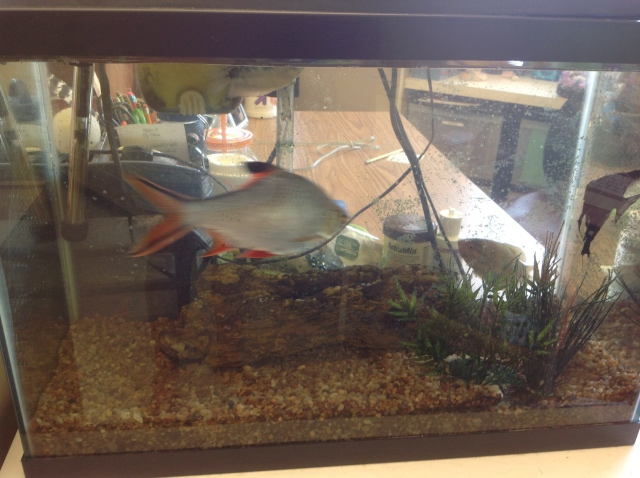 Fresh Water Fish
Question
My Fish Tank
Hi Elizabeth,
I would rea
Fresh Water Fish
Question
My Fish Tank
Hi Elizabeth,
I would rea
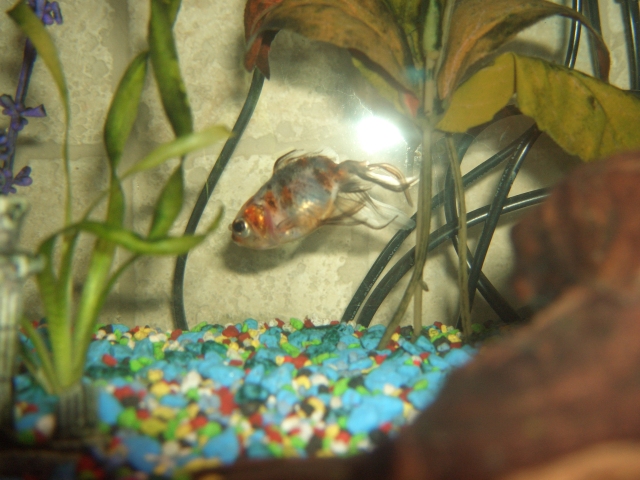 My sons Calico Orando - Bubbles!
QuestionBubbles
QUESTION: Weve had Bubbles for a
My sons Calico Orando - Bubbles!
QuestionBubbles
QUESTION: Weve had Bubbles for a